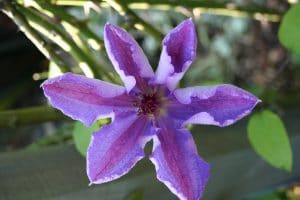We’ve already examined the different Royal Horticultural Society pruning groups in previous posts (see here for the first group article). Species of Clematis fall into three separate pruning groups, depending on when they flower. To help simplify things for you, we’re going to have a look at each of those groups here, considering when, why and how to prune each category.

Group 1
When to prune?
Mid- to late spring, but not necessarily every year. Regular removal of faded blooms keeps the plant looking cleaner.
Why in mid- to late-spring?
Clematis in group one flower early in the year, before this time. Its flowers develop on growth put on in the previous season. Pruning from April to May ensures all buds have bloomed and died off, and allows the rest of the year to produce future flowering material.
How?
Prune back dead flowerheads to healthy buds. You can shear over the more vigorous bushy species such as C. montana with less care.
Group 2
When to prune?
February initially, then again in summer after the first flush of blooms has faded. Again, annual pruning is not necessarily required.
Why?
The February prune is to cut back to an ideal framework of older growth, yet promoting new shoots to arise on which this year’s flowerbuds will develop. Pruning in summer is to encourage a second flush of flowers before the year’s end. Clematis in group two bear the biggest blooms, between May and June.
How?
Remove weak or damaged older stems, cutting back to a sturdy, healthy pair of buds.
In the summer pruning, cut flowered stems back to healthy buds.
It’s possible to chop these Clematis back hard to 30-90cm above ground level to renew the plant. Do this in late winter and expect just a single flush of flowers the following summer.
Group 3
When to prune?
February pruning for this group too.
Why in February?
These Clematis produce flowers on the end 60cm of new growth. Failure to prune these regularly results in bare, tangled lower stems and flowers lost in the aether.
How?
Chop members of this group back close to base, leaving a pair of healthy buds on each stem. The plant will be reinvigorated each year, well in advance of its late summer flowering.
Kevin Gelder
Kevin joined Bestall & Co in late 2017 and brought a range of skills with him from a varied background. He gained a degree in French and Italian from Lancaster University in 2009 before successfully completing a PGCE at the University of Sheffield in 2011. He built on his communication skills through secondary language teaching, before working in healthcare administration.
Ultimately though it was his passion for plants and gardening which brought him to Bestall & Co as a member of the planting team, and although he's now moved back to an office based role, the articles he wrote whilst he was still with us live on.




